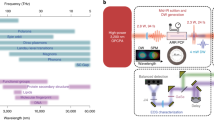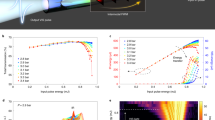Abstract
A coherent, compact and robust light source with coverage from the ultraviolet to the infrared is desirable for heterodyne super-resolution imaging1, broadband infrared microscopy2, protein structure determination3 and standoff trace-gas detection4. To address these demanding problems, frequency combs5 combine absolute frequency accuracy with sub-femtosecond timing and waveform control to enable high-resolution, high-speed and broadband spectroscopy6,7,8,9. Here we demonstrate a scalable source of near-single-cycle pulses from robust and low-noise erbium fibre (Er:fibre) technology. With a peak power of 0.56 MW we generate a comb spanning six octaves, from the ultraviolet (350 nm) to the mid-infrared (22,500 nm), achieving a resolving power of 1010 across 0.86 PHz of bandwidth. Second-order nonlinearities in LiNbO3, GaSe and CdSiP2 provide phase-stable infrared ultrashort pulses with simultaneous brightness exceeding a synchrotron10, while cascaded nonlinearities in LiNbO3 yield four octaves simultaneously (0.350–5.6 μm). We anticipate that these advances will be enabling for basic and applied spectroscopy, microscopy and phase-sensitive nonlinear optics.
This is a preview of subscription content, access via your institution
Access options
Access Nature and 54 other Nature Portfolio journals
Get Nature+, our best-value online-access subscription
$29.99 / 30 days
cancel any time
Subscribe to this journal
Receive 12 print issues and online access
$209.00 per year
only $17.42 per issue
Buy this article
- Purchase on Springer Link
- Instant access to full article PDF
Prices may be subject to local taxes which are calculated during checkout




Similar content being viewed by others
Data availability
The data supporting the findings of this study are available from D.M.B.L. upon reasonable request.
Code availability
Nonlinear Schrödinger equation code is available from citations in the Supplementary Information as well as from D.M.B.L. upon reasonable request.
References
Yang, F., Tashchilina, A., Moiseev, E. S., Simon, C. & Lvovsky, A. I. Far-field linear optical superresolution via heterodyne detection in a higher-order local oscillator mode. Optica 3, 1148–1152 (2016).
Wetzel, D. L. & LeVine, S. M. Imaging molecular chemistry with infrared microscopy. Science 285, 1224–1225 (1999).
Williams, R. W. & Dunker, A. K. Determination of the secondary structure of proteins from the amide I band of the laser Raman spectrum. J. Mol. Biol. 152, 783–813 (1981).
Rieker, G. B. et al. Frequency-comb-based remote sensing of greenhouse gases over kilometer air paths. Optica 1, 290–298 (2014).
Diddams, S. A., Vahala, K. & Udem, T. Optical frequency combs: coherently uniting the electromagnetic spectrum. Science 369, eaay3676 (2020).
Coddington, I., Newbury, N. & Swann, W. Dual-comb spectroscopy. Optica 3, 414–426 (2016).
Kowligy, A. S. et al. Infrared electric field sampled frequency comb spectroscopy. Sci. Adv. 5, eaaw8794 (2019).
Ideguchi, T. et al. Coherent Raman spectro-imaging with laser frequency combs. Nature 502, 355–358 (2013).
Bjork, B. J. et al. Direct frequency comb measurement of OD + CO → DOCO kinetics. Science 354, 444–448 (2016).
Bosch, R. A. Computed flux and brightness of infrared edge and synchrotron radiation. Nucl. Instrum. Methods Phys. Res. A 454, 497–505 (2000).
Hollas, J. M. Modern Spectroscopy 4th edn (Wiley, 2004).
Ramasesha, K., De Marco, L., Mandal, A. & Tokmakoff, A. Water vibrations have strongly mixed intra- and intermolecular character. Nat. Chem. 5, 935–940 (2013).
Ostaszewski, C. J. et al. Effects of coadsorbed water on the heterogeneous photochemistry of nitrates adsorbed on TiO2. J. Phys. Chem. A 122, 6360–6371 (2018).
Mendelsohn, R., Flach, C. R. & Moore, D. J. Determination of molecular conformation and permeation in skin via IR spectroscopy, microscopy, and imaging. Biochim. Biophys. Acta Biomembr. 1758, 923–933 (2006).
Dudley, J. M., Genty, G. & Coen, S. Supercontinuum generation in photonic crystal fiber. Rev. Mod. Phys. 78, 1135–1184 (2006).
Vasilyev, S. et al. Multi-octave visible to long-wave IR femtosecond continuum generated in Cr:ZnS-GaSe tandem. Opt. Express 27, 16405–16412 (2019).
Hugi, A., Villares, G., Blaser, S., Liu, H. C. & Faist, J. Mid-infrared frequency comb based on a quantum cascade laser. Nature 492, 229–233 (2012).
Steinle, T., Mörz, F., Steinmann, A. & Giessen, H. Ultra-stable high average power femtosecond laser system tunable from 1.33 to 20 μm. Opt. Lett. 41, 4863–4866 (2016).
Maidment, L., Schunemann, P. G. & Reid, D. T. Molecular fingerprint-region spectroscopy from 5 to 12 μm using an orientation-patterned gallium phosphide optical parametric oscillator. Opt. Lett. 41, 4261–4264 (2016).
Gambetta, A. et al. Milliwatt-level frequency combs in the 8–14 μm range via difference frequency generation from an Er:fiber oscillator. Opt. Lett. 38, 1155–1157 (2013).
Soboń, G., Martynkien, T., Mergo, P., Rutkowski, L. & Foltynowicz, A. High-power frequency comb source tunable from 2.7 to 4.2 μm based on difference frequency generation pumped by an Yb-doped fiber laser. Opt. Lett. 42, 1748–1751 (2017).
Smolski, V. et al. Half-Watt average power femtosecond source spanning 3–8 μm based on subharmonic generation in GaAs. Appl. Phys. B 124, 101 (2018).
Rosenband, T. et al. Frequency ratio of Al+ and Hg+ single-ion optical clocks; metrology at the 17th decimal place. Science 319, 1808–1812 (2008).
Nakamura, T. et al. Coherent optical clock down-conversion for microwave frequencies with 10−18 instability. Science 368, 889–892 (2020).
Riek, C. et al. Direct sampling of electric-field vacuum fluctuations. Science 350, 420–423 (2015).
Huber, R., Brodschelm, A., Tauser, F. & Leitenstorfer, A. Generation and field-resolved detection of femtosecond electromagnetic pulses tunable up to 41 THz. Appl. Phys. Lett. 76, 3191–3193 (2000).
Timmers, H. et al. Molecular fingerprinting with bright, broadband infrared frequency combs. Optica 5, 727–732 (2018).
Pupeza, I. et al. High-power sub-two-cycle mid-infrared pulses at 100 MHz repetition rate. Nat. Photon. 9, 721–724 (2015).
Elu, U. et al. High average power and single-cycle pulses from a mid-IR optical parametric chirped pulse amplifier. Optica 4, 1024–1029 (2017).
Lind, A. J. et al. Mid-infrared frequency comb generation and spectroscopy with few-cycle pulses and χ(2) nonlinear optics. Phys. Rev. Lett. 124, 133904 (2020).
Elahi, P., Kalaycıoğlu, H., Li, H., Akçaalan, Ö. & Ilday, F. Ö. 175 fs-long pulses from a high-power single-mode Er-doped fiber laser at 1550 nm. Opt. Commun. 403, 381–384 (2017).
Krauss, G. et al. Synthesis of a single cycle of light with compact erbium-doped fibre technology. Nat. Photon. 4, 33–36 (2010).
Bechtel, H. A., Johnson, S. C., Khatib, O., Muller, E. A. & Raschke, M. B. Synchrotron infrared nano-spectroscopy and -imaging. Surf. Sci. Rep. 75, 100493 (2020).
Riek, C. et al. Subcycle quantum electrodynamics. Nature 541, 376–379 (2017).
Chaitanya Kumar, S. et al. High-power femtosecond mid-infrared optical parametric oscillator at 7 μm based on CdSiP2. Opt. Lett. 40, 1398–1401 (2015).
Jones, R. J., Moll, K. D., Thorpe, M. J. & Ye, J. Phase-coherent frequency combs in the vacuum ultraviolet via high-harmonic generation inside a femtosecond enhancement cavity. Phys. Rev. Lett. 94, 193201 (2005).
Krausz, F. & Ivanov, M. Attosecond physics. Rev. Mod. Phys. 81, 163–234 (2009).
Okubo, S., Onae, A., Nakamura, K., Udem, T. & Inaba, H. Offset-free optical frequency comb self-referencing with an f–2f interferometer. Optica 5, 188–192 (2018).
Acknowledgements
The mention of specific companies, products or tradenames does not constitute an endorsement by the National Institute of Standards and Technology (NIST). We thank T. Schibli for his contributions and P. Schunemann and K. Zawilski at BAE for providing the CSP crystal, as well as I. Coddington, D. Carlson and M. Hummon for their manuscript feedback. D.M.B.L. and A.K. acknowledge award 70NANB18H006 from NIST. This research was supported by the Defense Advanced Research Projects Agency SCOUT Program, the Air Force Office of Scientific Research (FA9550-16-1-0016) and NIST.
Author information
Authors and Affiliations
Contributions
H.T., A.K., A.J.L., D.M.B.L. and S.A.D. developed the concept. D.M.B.L., H.T., S.X., A.K. and A.J.L. built and performed the experiments. D.M.B.L. and H.T. analysed the data. D.M.B.L., H.T. and S.A.D. wrote the manuscript with input from all authors.
Corresponding authors
Ethics declarations
Competing interests
The authors declare no competing interests.
Additional information
Peer review information Nature Photonics thanks the anonymous reviewers for their contribution to the peer review of this work.
Publisher’s note Springer Nature remains neutral with regard to jurisdictional claims in published maps and institutional affiliations.
Supplementary information
Supplementary Information
Supplementary Figs. 1–3 and discussion.
Rights and permissions
About this article
Cite this article
Lesko, D.M.B., Timmers, H., Xing, S. et al. A six-octave optical frequency comb from a scalable few-cycle erbium fibre laser. Nat. Photonics 15, 281–286 (2021). https://doi.org/10.1038/s41566-021-00778-y
Received:
Accepted:
Published:
Issue Date:
DOI: https://doi.org/10.1038/s41566-021-00778-y
This article is cited by
-
Visible-to-ultraviolet frequency comb generation in lithium niobate nanophotonic waveguides
Nature Photonics (2024)
-
Genetic algorithm-enhanced microcomb state generation
Communications Physics (2024)
-
350-2500 nm supercontinuum white laser enabled by synergic high-harmonic generation and self-phase modulation
PhotoniX (2023)
-
Highly efficient octave-spanning long-wavelength infrared generation with a 74% quantum efficiency in a χ(2) waveguide
Nature Communications (2023)
-
GaAs-chip-based mid-infrared supercontinuum generation
Light: Science & Applications (2023)



